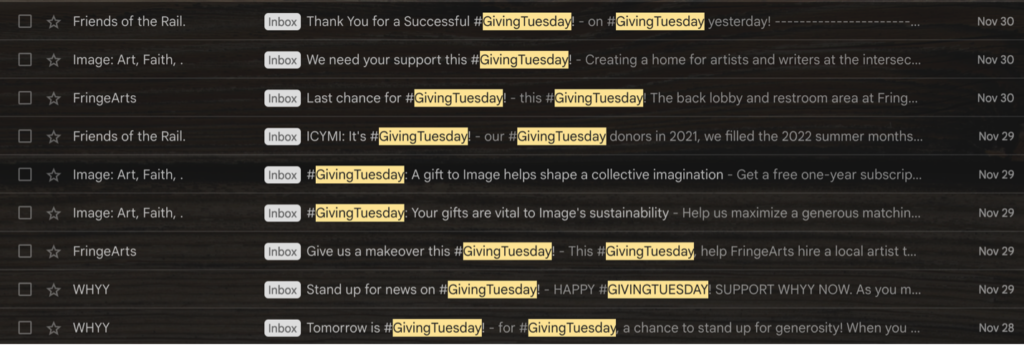The good, the bad, and the ugly from 2022—and how you can learn from it.
Giving Tuesday is now just days away!
Sorry, didn’t mean to panic you.
Hopefully by now you’re finalizing segments and scheduling emails ahead of time. But if you haven’t quite finished up your Giving Tuesday draft, fret not. Sometimes, the most effective email is the one you write under pressure.
Whether you are just putting the final touches on your campaign or looking for inspiration before you draft, here are a few takeaways from last year’s Giving Tuesday efforts:
1. Don’t skip Giving Tuesday just because email revenue isn’t a big deal for you.
I know everyone and her brother does Giving Tuesday, but just because you might personally find it passé doesn’t mean your donors do. In 2022, $3.1 billion was donated on Giving Tuesday—15% more revenue than 2021. There’s a reason everybody does it: it works. And besides that, growing a grassroots direct response program is crucial to the overall health of your organization. Where are you going to find major donors if you don’t build the bottom of your donor pyramid? Small donors matter. Not just because of your mission, but because of your growth plan.
2. Make sure you include “Giving Tuesday” in the subject line.
Last year, we saw a number of groups send beautiful Giving Tuesday emails . . . without mentioning Giving Tuesday in the subject line. Some people put it in the preview text, some ignored it all together. Face it, the Giving Tuesday brand is bigger than yours. Enjoy the secondhand limelight and align your nonprofit with a trusted brand. And, for that matter, don’t be afraid to use free Giving Tuesday graphics if you don’t have your own designer.
3. For the love of all that is clickable, do not bury the lede (aka the matching gift).
Sadly, more than one nonprofit completely failed the scan test for their most important message—the matching gift. On this day more than any other, you must make your value proposition extremely clear. No subscriber should be able to miss the point. Those who delete without opening should see the match somewhere in your subject line or preheader. Those who open and quickly delete should be able to scan your email and catch the match details in BIG BOLD LETTERS in just a few seconds, and for those loyal readers who make it all the way to the bottom of the email, the match should be the final impression on their mind through a clear call-to-action (with a deadline reminder!) in the P.S.
4. Do not under any circumstance include links other than donation links.
Two groups I follow included links to a handful of URLs that were NOT donation links last year. These two groups are dead to me. Do yourself a favor and delete all non-donation links from hard solicitation emails. You don’t want to add opportunities for your readers to get distracted.
5. Send a second email in the afternoon.
Last year, after opening and clicking (but not donating to) several organizations’ morning emails, I was surprised not to get an afternoon 'double blast' update email from about half of them. By opening your email in the morning, I was raising my hand for more info. Sadly, that info was not supplied.
6. If you have a texting program, align it with your email campaign.
A few nonprofits I support have texting programs, but surprisingly they did not utilize it for Giving Tuesday. Text-to-give programs survive and thrive on urgency, so it was disappointing to see this missed opportunity. Don’t be that guy!
7. Get the match, even if you think it’s “small.”
You might see bigger organizations that are able to front $25,000 or $50,000 for a matching gift, but that doesn’t mean you have to go big or go home. For most nonprofits, a match of even $5,000 helps move the needle, not just on your revenue goal, but on your new donor numbers. According to the Giving Tuesday gurus, donor acquisition spikes 550% on Giving Tuesday. As a practitioner, I’m inclined to believe it. Matching challenges don’t have to break the bank to be impactful, so don’t shy away from trying a match of $5,000 or $10,000 for your year-end match in December. Any match is better than no match, and if the match is on the smaller side, it may even make the momentum feel bigger.
8. Personalize your existing newsletters in the week of Giving Tuesday.
If you have a loyal subscriber audience, let them know how much they mean to you by taking the time to personalize newsletters next week. These people spend time with you every week, often over coffee first thing in the morning. Whether or not it feels like it to you, you’ve cultivated an intimate relationship with them.
Sadly, competition in the inbox keeps getting stiffer. More and more for-profit companies are trying to grift on Giving Tuesday these days, and many are even extending their Cyber Monday deals into the next day.
Luckily for you, there are eight things you can (probably) be doing better to cut through the noise above.
Godspeed!
And if you want to talk about how you can invest in digital fundraising in 2024 so you don’t have to panic next Giving Tuesday, sign up for a free consultation any time.






